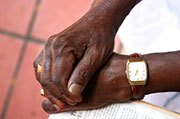
TUESDAY, Sept. 15, 2015 (HealthDay News) — Higher-earning black Americans seem to die sooner after a heart attack than whites, according to researchers who say they’ve uncovered a new twist on the “survival gap” theory.
Historically, income differences were considered a key reason why black cardiac patients tend to fare worse than better-off whites. But this study, based on heart attack patients in the 1990s, finds the gap between the races was widest among the richest people.
White Medicare patients in the wealthiest neighborhoods lived an average of seven years after a heart attack, while blacks in those areas lived 6.3 years. The difference between poor white patients (5.6 years) and poor black patients (5.4 years) was smaller, the study found.
“We expected to see the reverse,” said study lead author Dr. Emily Bucholz of Boston Children’s Hospital. “Instead, the greatest gap in life expectancy between black and white patients occurred in high-income patients, which was surprising to us.”
The reasons for the gap aren’t yet known, and the study doesn’t say anything about current health care since it’s based on heart attacks suffered two decades ago.
Researchers have documented differences in care between blacks and whites for decades, said cardiologist Dr. Quinn Capers IV, an associate professor of medicine at Ohio State University College of Medicine. He was not involved with the current study.
“We know that racial health care disparities exist in cancer care, diabetes care, cardiac care and many other areas, and the disparity is always in the same direction: Whites are more likely to receive high-quality care than blacks,” Capers said.
But researchers don’t know why the difference persists.
In the new study, researchers examined the records of nearly 142,000 Medicare patients aged 65 to 90 who had heart attacks between 1994 and 1996. The study followed them for the next 17 years.
The life span differences were especially significant given the ages of the patients, Bucholz said.
“In 65-year-old patients, the differences in white-black life expectancy after heart attack were 3.25 years among patients living in high-income areas and 2.15 years among patients living in low-income areas,” she said. “When one considers that the average life expectancy of a 65-year-old person is 19 years, two to three years is actually a pretty sizable difference.”
What’s going on? For one thing, blacks had more risk factors for heart disease such as smoking and diabetes, and they were less likely to be treated, the researchers found. Other research suggests that racial differences could be due to discrimination, the study pointed out.
Under one theory, “a middle-class black man and a middle-class white man may both seek medical attention at the same high-quality hospital with highly trained doctors. But if the treating physician has either explicit or unconscious racial bias against the blacks, he may be less likely to offer all treatments and diagnostic tests to the black man, and may be less compassionate when treating him,” Capers said.
Also, minorities living in upper-income neighborhoods, which may have a lot of white residents, have been shown to have poorer health than those living in areas with more people of their own race, the researchers said in background notes.
So, poor blacks and poor whites may be more comfortable in the same neighborhoods, Capers said, and that could explain why there’s less difference between how they fare in terms of health. Still, “these are just theories that are difficult to prove,” he added.
Capers said it would help black patients to have a family member present as an advocate when dealing with life-threatening issues. Also, doctors should consider their potential to discriminate and take tests that aim to detect unconscious bias, he said.
The study appears in the Sept. 14 issue of Circulation.
More information
For more about racial health disparities, see the U.S. National Institutes of Health.
Copyright © 2025 HealthDay. All rights reserved.

